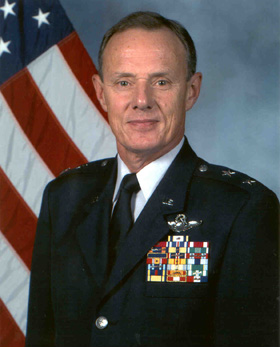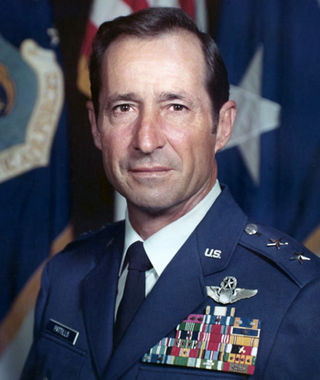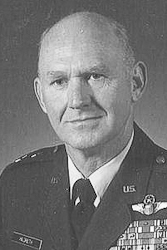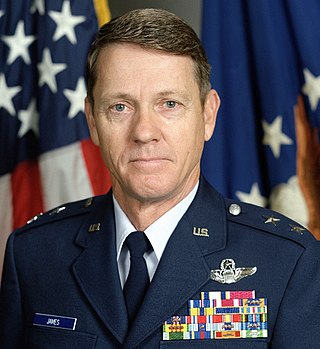
General James Burr Davis is a retired United States Air Force (USAF) general and was chief of staff, Supreme Headquarters Allied Powers Europe in Mons, Belgium.

Jimmie Vick Adams is a retired four-star general in the United States Air Force (USAF). He served as commander in chief, Pacific Air Forces (CINCPACAF) from 1991 to 1993.

Kenneth Walter North was a brigadier general in the United States Air Force as well as a prisoner of war during the Vietnam War. After his release, he commanded various units and was eventually promoted to general in 1982.

Billy Martin Minter was a four-star general in the United States Air Force (USAF). He served as commander in chief, United States Air Forces in Europe and commander of Allied Air Forces Central Europe, with headquarters at Ramstein Air Base, West Germany.

Robert Dale Russ was a United States Air Force (USAF) general and commander of Tactical Air Command.

Jack Irvin Gregory is a former general in the United States Air Force and the former commander in chief of the Pacific Air Forces.

Philip G. Killey is a retired United States Air Force officer. He attained the rank of major general, and served as Adjutant General of the South Dakota National Guard, Director of the Air National Guard and Commander of First Air Force.

James Montgomery Breedlove was an American air force major general who was commander, U.S. Air Force Southern Air Division of the Tactical Air Command and deputy commander in chief, United States Southern Command, Quarry Heights, Canal Zone.

Harrison Lobdell Jr. was an American Air Force major general who was commandant, National War College, National Defense University, Fort Lesley J. McNair, Washington, D.C. from 1976 to 1978.

Charles Curtis Pattillo, also known as Buck Pattillo, was an American Air Force lieutenant general who was deputy commander in chief, U.S. Readiness Command and vice director of the Joint Deployment Agency with headquarters at MacDill Air Force Base, Florida. He died in May 2019 at the age of 94.

Lloyd Richardson Leavitt Jr. was an American Air Force lieutenant general. As vice commander in chief of the Strategic Air Command, Offutt Air Force Base, Nebraska, he fulfilled the responsibilities of the SAC commander in chief in his absence. He was also the commander's principal adviser in the formulation of SAC policies, plans, and directives.

James Robert Hildreth was a major general in the United States Air Force who served as commander of Thirteenth Air Force at Clark Air Base in the Philippines.

James Robert Brown was a lieutenant general in the United States Air Force who served as vice commander of Tactical Air Command, with headquarters at Langley Air Force Base, Virginia. The command comprises more than 118,000 military and civilian personnel, stationed at 18 major Tactical Air Command installations and other units in the United States, Panama, Okinawa and Iceland. Tactical Air Command was the operational combat organization for 74,000 Air National Guard and Air Force Reserve personnel throughout the United States.

Craven C. Rogers Jr. was a lieutenant general in the United States Air Force who served as deputy commander in chief of the U.S. Central Command at MacDill Air Force Base, Florida. The command was tasked with achieving United States national objectives in Southwest Asia, the Persian Gulf, and the Horn of Africa. Rogers was born in 1934, in Galveston, Texas. He earned a Bachelor of Science degree in engineering from the U.S. Military Academy in 1957 and a master's degree in business administration from The George Washington University. He completed Squadron Officer School in 1962 and the Industrial College of the Armed Forces in 1973. Upon graduation from the academy he was commissioned as a second lieutenant in the Air Force. After completing pilot training in September 1958 he was assigned to Tactical Air Command at Williams Air Force Base, Ariz., for gunnery training in the F-86F. With the phaseout of the F-86F, Rogers transferred in June 1959 as an instructor pilot to Air Training Command, Vance Air Force Base, Oklahoma. He completed F-101A transition training in September 1964 and then was assigned as a tactical fighter pilot with the 91st Tactical Fighter Squadron, Royal Air Force Station Bentwaters, England. In 1965 his squadron became the first unit in the United States Air Forces in Europe to transition to the F-4. Rogers assumed duties in the Standardization and Evaluation Section of the 81st Tactical Fighter Wing at Bentwaters in November 1966. In September 1967 he transferred to Nellis Air Force Base, Nevada, where he completed the F-4 Fighter Weapons School. In January 1968 he was assigned to the 557th Tactical Fighter Squadron, 12th Tactical Fighter Wing, Cam Ranh Bay Air Base, South Vietnam, as a flight commander and squadron weapons officer. He subsequently served as the wing weapons officer and assistant chief of weapons and tactics for 12th Tactical Fighter Wing. He flew 255 combat missions and 435 combat flying hours in the F-4C. He returned from Southeast Asia in February 1969 and was assigned to the Fighter and Reconnaissance Manning Section, Air Force Military Personnel Center, Randolph Air Force Base, Texas. He became chief of the section in 1971. Upon graduation from the Industrial College of the Armed Forces in August 1973, Rogers became deputy commander for operations, 1st Tactical Fighter Wing, MacDill Air Force Base, Florida. In June 1975 he transferred to Headquarters United States Air Force, Washington, D.C., as chief, Tactical Division, Directorate of Operational Requirements, Office of the Deputy Chief of Staff, Research and Development. In July 1977 Rogers was assigned as vice commander of the 4th Tactical Fighter Wing, Seymour Johnson Air Force Base, North Carolina. In June 1978 he became commander of the wing. He returned to Air Force headquarters in July 1980 and served as military assistant to the secretary of the Air Force. From June 1983 to July 1985 he was commander of United States Air Forces Korea; commander, United Nations Command Air Component; and commander, 314th Air Division, with headquarters at Osan Air Base, South Korea. He also was commander of the Korean Air Defense Sector, director of readiness and combat operations, and chief of staff of the Air Component Command/Combined Forces Command. Rogers then transferred to Hickam Air Force Base, Hawaii, as vice commander in chief, Pacific Air Forces. In December 1986 Rogers returned to Osan Air Base as commander, 7th Air Force; deputy commanding general, U.S. Forces Korea (Seoul); and deputy commander in chief, United Nations Command (Seoul). He is a command pilot with 5,200 flying hours. His military awards and decorations include the Defense Distinguished Service Medal with oak leaf cluster, Distinguished Service Medal, Legion of Merit with two oak leaf clusters, Distinguished Flying Cross with oak leaf cluster, Bronze Star Medal, Meritorious Service Medal with oak leaf cluster, Air Medal with 13 oak leaf clusters, Air Force Commendation Medal, Korean Order of National Security Merit (Chunsu) and Korean Order of National Security Merit (Kuksun). He was promoted to lieutenant general January 1, 1987, with same date of rank. He retired on April 1, 1991, and died on August 4, 2016.

John James Closner III was a major general in the United States Air Force who served as commander of the United States Air Force Reserve Command, Headquarters U.S. Air Force, Washington D.C., and commander, Headquarters Air Force Reserve, a separate operating agency located at Robins Air Force Base, Georgia. As chief of the Air Force Reserve, he served as the principal adviser on Reserve matters to the Air Force Chief of Staff. As commander of AFRES, he had full responsibility for the supervision of U.S. Air Force Reserve units around the world.

David R. Smith was a major general in the United States Air Force who served as Commander of the United States Air Force Reserve Command, Headquarters U.S. Air Force, Washington D.C., and commander, Headquarters Air Force Reserve, a separate operating agency located at Robins Air Force Base, Georgia. As chief of Air Force Reserve, he served as the principal adviser on Reserve matters to the Air Force Chief of Staff. As commander of AFRES, he had full responsibility for the supervision of U.S. Air Force Reserve units around the world. He was also commander of the 10th Air Force.

John A. Bradley was a lieutenant general in the United States Air Force who served as Commander of the United States Air Force Reserve Command, Headquarters U.S. Air Force, Washington D.C., and commander, Headquarters Air Force Reserve, a separate operating agency located at Robins Air Force Base, Georgia. As chief of Air Force Reserve, he served as the principal adviser on Reserve matters to the Air Force Chief of Staff. As commander of AFRES, he had full responsibility for the supervision of U.S. Air Force Reserve units around the world.

George David Miller is a retired American Air Force lieutenant general whose last assignment was vice commander in chief, Strategic Air Command, headquartered at Offutt Air Force Base, Nebraska. He assumed this position September 1, 1981, and served until August 31, 1984.

Major General William K. James of United States Air Force, was director of the Defense Mapping Agency (DMA) between June 1990 and June 1993. Under his leadership Major General James redirected the DMA – a heritage organization of the National Geospatial-Intelligence Agency – from producing products to meet the requirements of the Cold War to a concept of a Global Geospatial Information System (GGIS) directly accessible to combat commanders of the Rapid Deployment Forces. The GGIS was a major paradigm shift in warfare with the delivery of geographic information to fast-moving military forces.

Melbourne Kimsey was a brigadier general in the United States Air Force who served as director of the Cheyenne Mountain Complex from 1981 to 1983,



















